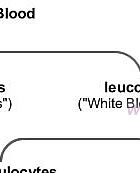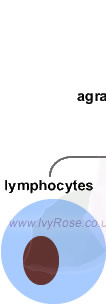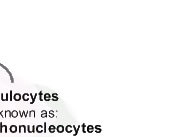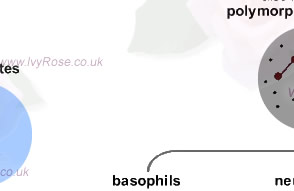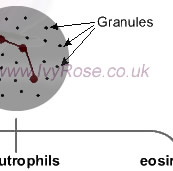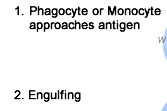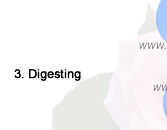The Structure and Functions of Blood
This page is divided into the following sections:
- The Functions of Blood
(generally - as opposed to the functions of particular components of blood).
- The Composition of Blood
(incl. the different types of blood cells and their properties and functions).
- Process of Oxygenation of Tissues due to Circulation of Blood
- Types of Leucocytes (White Blood Cells)
1. Functions of Blood
- Transports
- Dissolved gases (e.g. oxygen, carbon dioxide)
- Waste products of metabolism (e.g. water, urea)
- Hormones
- Enzymes
- Nutrients (such as glucose, amino acids, micro-nutrients (vitamins & minerals), fatty acids, glycerol)
- Plasma proteins (associated with defence, such as blood-clotting and anti-bodies)
- Blood cells (incl. white blood cells 'leucocytes', and red blood cells 'erythrocytes').
- Maintains Body Temperature
- Controls pH
The pH of blood must remain in the range 6.8 to 7.4, otherwise it begins to damage cells.
- Removes toxins from the body
The kidneys filter all of the blood in the body (approx. 8 pints), 36 times every 24 hours. Toxins removed from the blood by the kidneys leave the body in the urine. (Toxins also leave the body in the form of sweat.)
- Regulation of Body Fluid Electrolytes
Excess salt is removed from the body in urine, which can contain around 10g salt per day in the cases of people eating 'western' diets that contain more salt than the body requires.
|
2. Composition of Blood
Blood consists of many component parts (constituents).
These include:
- 55% Plasma
- 45% Components (sometimes called 'formed elements'), i.e. blood cells.
Of these,
This is summarised in the following diagram, and described in further detail below.
The summary chart above includes: erythrocytes (red blood cells), thrombocytes (blood platelets) and leucocytes (white blood cells). It also includes categories of leucocytes: agranulocytes and granulocytes (also known as polymorphonucleocytes), which may also be sub-divided into lymphocytes, monocytes, basophils, neutrophils and eosinophils.
The following table includes further general information about the constituents of blood.
|
Structure |
Functions |
Plasma |
Normal blood plasma is 90-92 % water.
This is the straw-coloured fluid in which the blood cells are suspended, and consists of:
- Dissolved substances including electrolytes such as sodium, chlorine, potassiun, manganese, and calcium ions
- Blood plasma proteins (albumin, globulin, fibrinogen)
- Hormones
|
- The medium in which the blood cells are transported around the body (by the blood vessels) and are able to operate effectively.
- Helps to maintain optimum body temperature throughout the organism.
- Helps to control the pH of the blood and the body tissues, maintaining this within a range at which the cells can thrive.
- Helps to maintain an ideal balance of electrolytes in the blood and tissues of the body.
|
|
Erythrocytes
(Red blood cells) |
- Immature erythrocytes have a nucleus but mature erythrocytes have no nucleus.
- Erythrocytes have a "prosthetic group" (meaning "in addition to" - in this case, in addition to the cell). The active component of this prosthetic group is Haem.
Haem
relies on the presence
of iron (Fe).
Haem
combines with oxygen
to form oxyhaemoglobin: 
 ...
continued in section
below ...
continued in section
below
- Erythrocytes are eventually broken down by the spleen into the blood pigments bilinubin and bilviridin, and iron. These components are then transported by the blood to the liver where the iron is re-cycled for use by new erythrocytes, and the blood pigments form bile salts. (Bile breaks down fats.)
- Have a longevity of approx. 120 days.
- There are approx. 4.5 - 5.8 million erythrocytes per micro-litre of healthy blood (though there are variations between racial groups and men / women).
|
- Carry oxygen (process described in more detail - below).
 |
|
Leucocytes
(White blood cells)
 |
- There are different types of leucocytes (described in more detail - below), classified as:
- Granular: e.g. Neutrophils, Eosinophils, Basophils.
- Agranular (do not contain granules): e.g. Monocytes, Lymphocytes.
- Have a longevity of a few hours to a few days (but some can remain for many years).
- There are approx. 5,000 - 10,000 leucocytes per micro-litre of blood.
|
- Major part of the immune system.
|
|
Trombocytes
(Platelets) |
- Blood platelets are cell fragments
- Approx disk-shaped fragments
- Diameter 2-4 um
(1 micro-metre = 1 um = 0.000001m)
- Have many granules but no nucleus
- Have a longevity of approx. 5-9 days
- There are approx. 150,000 - 400,000 platelets per micro-litre of blood
|
- To facilitate blood clotting - the purpose of which is to prevent loss of body fluids.
|
|
3. The Oxygenation of Blood
The oxygenation of blood is the function of the erythrocytes (red blood cells) and takes place in the lungs.
The sequence of events of the blood becoming oxygenated (in the lungs) then oxygenating the tissues (in the body) is as follows:
- The Right Ventricle (of the heart) sends de-oxygenated blood to the lungs.
- While in the lungs:
- Carbon Dioxide diffuses out of the blood into the lungs, and
- Oxygen (breathed into the lungs) combines with haemoglobin in the blood as it passes through the lung capillaries.
- Oxyhaemoglobin returns to the heart via the pulmonary vein and then enters the systemic circulation via the aorta.
- There is a low concentration of oxygen in the body tissues. They also contain waste products of the metabolism (such as carbon dioxide).
- Due to the high concentration of oxygen in the blood and the low concentration of oxygen in the tissues,

- ... the high concentration of carbon dioxide in the tissues diffuses into the blood. (95% of this carbon dioxide
dissolves in the blood plasma.)
- Blood returns from the tissues back to the heart via the superior vena cava (from the upper-body) and the inferior vena cava (from the lower-body)
4. Types of Leucocytes (White Blood Cells)
| Lymphocytes: |
Monocytes: |
|
*Basophils: |
*Neutrophils: |
*Eosinophils: |
| Approx. 24%
of leucocytes are lymphocytes. These produce
anti-bodies and include:
* T-Cells T-Cells
* B-Cells B-Cells
* Natural
Killer Cells Natural
Killer Cells |
Approx.
4% of leucocytes are monoocytes.
These are
also known as phagocytes.
They combat microbes by the process of phagocytosis. |
0.5-1%
of leucocytes are basophils.
Diameter 8-10 micro-metres.

Liberate heparin, histamine, and seratonin
in allergic reactions, intensifying inflammatory
response. |
60-70%
of leucocytes are neutrophils.
Diameter 10-12 micro-metres.

Phagocytosis. Destruction of bacteria with
lysozyme and strong oxidants. |
2-4%
of leucocytes are eosinophils.
Diameter 10-12 micro-metres.

Combat the effects of histamine in allergic
reactions;
Phagocytize antigen-antibody complexes; Destroy some parasitic worms. |
* It is only possible to observe the differences between these by staining them.
Further notes about the types of leucocytes identified above:
Lymphocytes:
- The word "antigen" is sometimes loosely used to refer to something that is not naturally present and 'should not be in the body'. However, in immunology, an antigen is defined as a substance that evokes the production of one or more antibodies. That is a better description, especially considering the importance of antigens re. blood groups.
- T Cells (lymphocytes) are activated by the thymus gland.
- B Cells (lymphocytes) are activated by other lymphoid tissue. The 'B' indicates 'bone marrow' cells.
- Both T-cells and B-cells:
(1) destroy antigens, and
(2) produce 'memory cells' and anti-bodies.
Basophils:
- An increased (higher than usual) percentage of basophils in the blood may indicate an inflammatory condition somewhere in the body.
Neutrophils & Monocytes:
- Neutrophils
are the first leucocytes to respond
to bacterial invasion of the body.
They act by carrying out the process
of phagocytosis (see opposite), and
also be releasing enzymes - such as
lysozyme, that destroy certain bacteria
- Monocytes take longer to reach
the site of infection than neutrophils
- but they eventually arrive in much
larger numbers. Monocytes that migrate
into infected tissues develop into
cells called wandering macrophages
that can phagocytize many more microbes
than neutrophils are able to.
Monocytes also clear up cellular debris
after an infection.
Eosinophils:
- An increased (higher than usual) percentage of eosinophils in the blood may indicate parasitic infection somewhere in the body.
|
|
Phagocytosis:
- A phagocyte is a cell able to engulf and digest bacteria, protozoa, cells, cell debris, and other small particles. Phagocytes include many leucocytes (white blood cells) and macrophages - which play a major role in the body's defence system.
- Phagocytosis is the engulfment and digestion of bacteria and other antigens by phagocytes.
This is illustrated below.
|
This is the end of this article but further information about blood vessels, the structure and functions of the heart, systemic circulation, and the vascular system generally are included on other pages of this website.
Note: The structure and function of blood vessels and other aspects of the vascular system is part of training in therapies such as massage incl. Indian head massage, Swedish massage, acupressure, aromatherapy, acupuncture, shiatsu, and others. This page is intended to include information suitable for most basic (first level) courses in these therapies,
and some ITEC Diplomas.
In the News:
 Saffron adopted through ABC's Adopt-an-Herb Program - 7 Apr '20
 World Health Day 2020: Support Nurses and Midwives - 7 Apr '20
 How to get along when staying at home - 31 Mar '20
 COVID-19 Mental health and social impact study - 23 Mar '20
 Kale is in season in February - 7 Feb '20
 Free to access online data about latest clinical research on novel coronavirus 2019-nCoV - 29 Jan '20
 Improving the relationship between use of social media and body image - 9 Jan '20
 Aromatherapy assoc. NAHA supports lavender via ABC's adopt-an-herb - 22 Dec '19
For 7th November
Notice the eternal aspects of the beauty around you today.
Yesterday's Angel
Thought
Angel Thoughts by IvyRose.
Although care has been taken when compiling this page, the information
contained might not be completely up to date. Accuracy cannot be guaranteed. This material is copyright.
See terms of use.
IvyRose Holistic 2003-2024.
|



